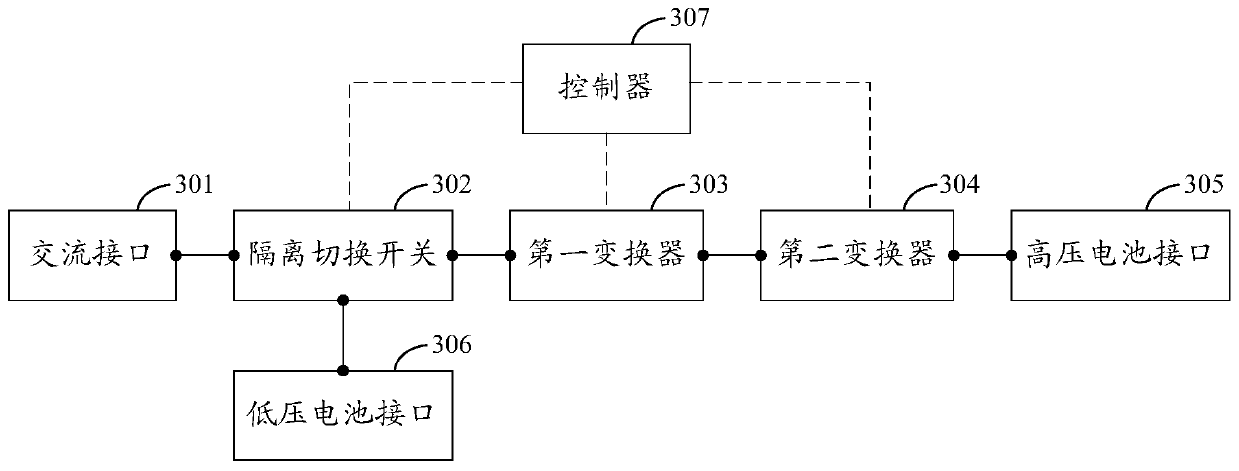Vehicle-mounted charging and discharging system and control method
A charge-discharge and controller technology, applied in battery/fuel cell control devices, charging stations, control/regulation systems, etc., can solve the impact of system conversion efficiency and reliability, poor cross-regulation rate of on-board charge-discharge systems, difficult Implement soft switching and other issues
- Summary
- Abstract
- Description
- Claims
- Application Information
AI Technical Summary
Problems solved by technology
Method used
Image
Examples
Embodiment 1
[0054] see image 3 , image 3 It is a schematic structural diagram of the on-board charging and discharging system provided by the embodiment of the present application. Such as image 3 As shown, the vehicle charging and discharging system includes: an AC interface 301 , an isolation switch 302 , a first converter 303 , a second converter 304 , a high voltage battery interface 305 , a low voltage battery interface 306 and a controller 307 .
[0055] The AC interface 301 is used to connect an AC power source or an AC load. Wherein, the AC power supply can be an external power supply for charging electric vehicles, such as charging piles, etc. When the AC power supply is connected to the AC interface 301, the controller 307 can control the isolation switch 302, the first converter 303 and the second converter The controller 304 controls the AC power supply to supply power to the high-voltage battery connected to the high-voltage battery interface 305 . The AC load can be a...
Embodiment 2
[0074] see Figure 8 , Figure 8 It is a schematic diagram of a circuit structure of an exemplary on-vehicle charging and discharging system provided in the embodiment of the present application.
[0075] Such as Figure 8 As shown, the first switch S1 is used as an isolation switch in the vehicle charging and discharging system; one end of the AC interface AC is connected to the first moving contact (contact 1) of the first switch S1, and the other end of the AC interface AC is connected to the first The first port of the converter 303; the positive terminal of the low-voltage battery interface LV BAT is connected to the second movable contact (contact 2) of the first switch S1, and the negative terminal of the low-voltage battery interface LV BAT is grounded. Normally, the low-voltage battery interface The negative port of the LV BAT can be grounded together with the first converter 303 ; the static contact (contact 3 ) of the first switch S1 is connected to the first port...
Embodiment 3
[0105] see Figure 9 , Figure 9 It is a schematic circuit diagram of another exemplary on-vehicle charging and discharging system provided in the embodiment of the present application.
[0106] Such as Figure 9 As shown, the isolation switch in the vehicle charging and discharging system may specifically include: a first switch S1 and a second switch S2. One end of the AC interface AC is connected to the first movable contact (contact 1) of the first switch S1, and the other end of the AC interface AC is connected to the first movable contact (contact 1*) of the second switch S2; the low-voltage battery interface LV The positive port of the BAT is connected to the common point M, which is the connection point between the second movable contact (contact 2) of the first switch S1 and the second movable contact (contact 2*) of the second switch S2; The negative terminal of the low-voltage battery interface LV BAT is grounded. Normally, the negative terminal of the low-voltag...
PUM
 Login to View More
Login to View More Abstract
Description
Claims
Application Information
 Login to View More
Login to View More - R&D
- Intellectual Property
- Life Sciences
- Materials
- Tech Scout
- Unparalleled Data Quality
- Higher Quality Content
- 60% Fewer Hallucinations
Browse by: Latest US Patents, China's latest patents, Technical Efficacy Thesaurus, Application Domain, Technology Topic, Popular Technical Reports.
© 2025 PatSnap. All rights reserved.Legal|Privacy policy|Modern Slavery Act Transparency Statement|Sitemap|About US| Contact US: help@patsnap.com



